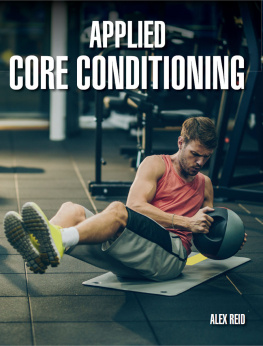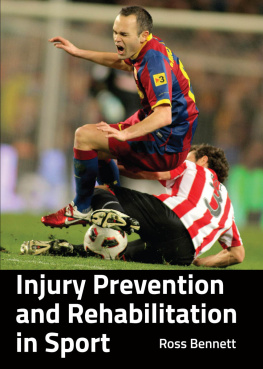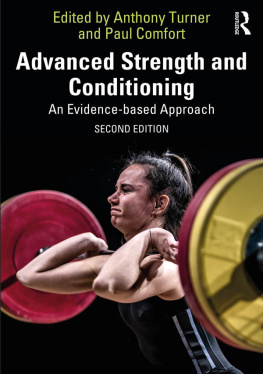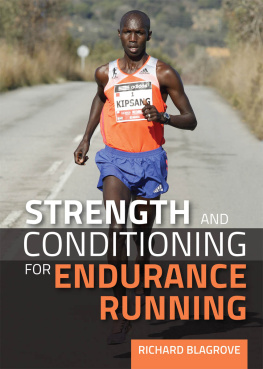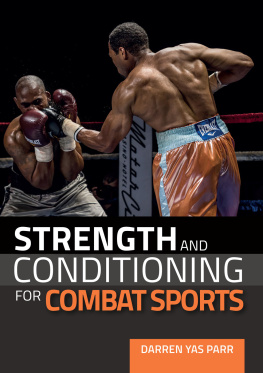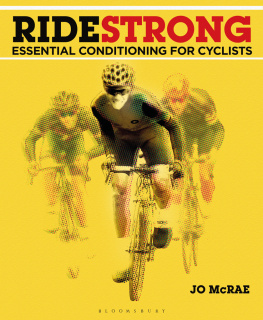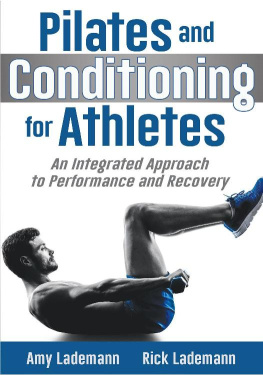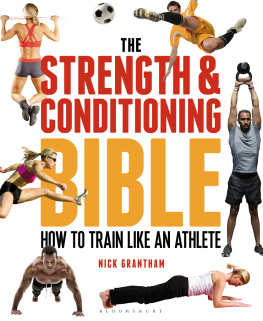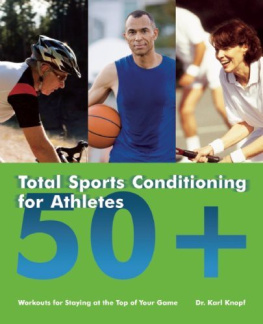APPLIED
CORE CONDITIONING

APPLIED
CORE CONDITIONING
ALEX REID

THE CROWOOD PRESS
First published in 2018 by
The Crowood Press Ltd
Ramsbury, Marlborough
Wiltshire SN8 2HR
www.crowood.com
This e-book first published in 2019
Alex Reid 2018
All rights reserved. This e-book is copyright material and must not be copied, reproduced, transferred, distributed, leased, licensed or publicly performed or used in any way except as specifically permitted in writing by the publishers, as allowed under the terms and conditions under which it was purchased or as strictly permitted by applicable copyright law. Any unauthorised distribution or use of this text may be a direct infringement of the author's and publisher's rights, and those responsible may be liable in law accordingly.
British Library Cataloguing-in-Publication Data
A catalogue record for this book is available from the British Library.
ISBN 978 0 78500 522 0
Dedication
For Malc. For Mum. For Dad. Thank you.
CONTENTS
ACKNOWLEDGEMENTS
Thank you to the following contributors within this book. Your efforts and the time given to help bring things together are greatly appreciated:
Core, anatomy and muscular images: Visualcoaching Pro (visualcoaching.com); Photography: Peter Court Media Services
The case studies in this book are anonymous, but I would like to thank my clients, who have provided me with insight and experience, and inspired me to provide optimal conditioning, rehabilitation and reconditioning programmes for them.
I would also like to thank my family, particularly Isla and Machrie, as well as my friends who have encouraged and supported me during the writing and creation of this book.
GETTING THROUGH THIS
I was asked to write this foreword as a fairly average person who was fit and healthy and worked hard at a lot of different things. I started running in my early thirties and quickly challenged myself to get faster and faster. I pushed myself quite hard and was fairly happy with my personal bests at 10k and half-marathon distances. Then, when I was thirty-five I ruptured my anterior cruciate ligament playing a bounce game of 5-a-side football. I went home after the game thinking I had done something bad. It was diagnosed by the physio the next day and all was confirmed by a MRI scan a couple of days later. I had little knowledge of the severity of this injury until I started my rehabilitation. Notwithstanding a second operation due to receiving an infection during my first operation, the journey back to running was an arduous, yearlong, pain-threshold-extending challenge. Ive never recovered fully from this and, with the exception of a burst of activity to beat my 10k personal best, Ive never got near my old cadence.
In 2017, six years after my ACL repair, I suffered a prolapsed disc in my lower back. Anyone who has ever experienced this (and you may well have if youre taking the time to read this book) will know the pain a body can go through. The ACL injury was nothing in comparison. Prolapsed discs dont usually happen because of a one-off episode. Instead, they usually build up over a prolonged period of time. I put mine down to a few years of imbalance after losing the ability to bend my right knee properly following the two ACL operations. Not being strong enough in my lower back, having poor posture and indulging in some rather savage sessions removing bamboo from our front drive, all conspired to create the perfect storm.
Six months after the prolapsed disc diagnosis, I am now able to run again, but those six months have been torture. It affects everything. Even trying to move an inch in bed is difficult. Your head thinks about your posture the whole day. It gets to you. You cant sit with your family and have a bit of fun. You cant lie on the floor, sit on a chair, cross the road fast, sit at your PC. You walk along the road and spasm. You stare at seats on the train trying to work out how to sit on them.
The only way you can recover is by getting stronger and preventing it from happening again. The core is the key. Every exercise that strengthens your trunk brings you one step closer to shaking off vulnerability. From my ACL recovery and strengthening everything around the knee, my focus has now shifted to strengthening my core. If only this book had already been written, and I had started earlier!
Anonymous
CHAPTER 1
INTRODUCTION:
WHAT IS THE CORE?
WHY IS IT IMPORTANT?
As you sit reading this, you will be subconsciously activating your abdominal muscles and trunk, commonly referred to as your core. Without this activation, our skeleton would be floppy, our spine unsupported and our overall function compromised. The muscles around our mid-section or trunk are constantly working to allow locomotion, smooth movement, control and function, and the activities that we do constantly demand this activation from the muscles involved.
Beth West, one of my good friends, posted the following on social media whilst on her journey to work in London one day in 2017:
Commuting on Southwest Trains of a morning is a tough core workout. Too crowded to be able to reach anything to hold on to, you must use your core to ensure that you are not toppling on to fellow passengers. They should market that. Maybe put some personal trainers on carriages and make it a proper workout!
A true reflection of the day-to-day challenges placed upon us all, it made me laugh out loud. Our core, lumbar spine, glutes, pelvis and associated limbs are constantly in use during our working day, with numerous actions requiring strength and control. When standing on a busy commuter train, we must stabilize and control our body all the time, in order not to fall on to the person next to us. It is a good example of a chaotic environment that we need to control, just like sport or lifting or working in a physical job. Every day, we place many demands on our body and expect it to cope. Sometimes we forget that, although the human body is made to work and move, if it is not properly conditioned, then injury is likely.
The body works as a global, combined unit. Despite a limb moving, it may appear, independently, on the contrary the movement is as a result of a number of combined, coordinated actions within the body: a neural, muscular, metabolic, conscious and subconscious decision to complete a movement made by a reaction to a stimulus, by choice, or sometimes involuntary, like reacting to a sudden move on that busy train, or reaching instinctively to catch something as it falls, or playing catch with your kids. It is very complex, but it works seamlessly on most occasions and allows us to be the mobile, skilled, dexterous beings that we are.
But what happens if we get injured? What if we are not strong enough to cope with these demands or have bad posture, which leads to pain and immobility? What if there is a leg-length discrepancy, which may lead to poor biomechanics and resultant back pain, or an over-use injury as a result of a muscular imbalance? How in those cases do we address the day-to-day issues and challenges? The solution lies in becoming stronger and better conditioned, ensuring good mobility, retraining our movement patterns, and reintroducing effective and efficient activation of the trunk and core musculature.
The muscles around the abdominal region, known widely as the core musculature, originate and insert within the axial skeletal system and link through to the appendicular skeleton. They are the link in the chain that coordinates our movement. Without them, movement would be clumsy and uncoordinated. The body works well as a unit, but sometimes it needs to be retrained and reeducated to take care of itself. It is very easy for it to become lazy, to adopt bad habits and become deactivated, which can cause problems. Often the larger, more dominant muscles are recruited before the more appropriate, synergistic muscles. This poor muscle recruitment can lead to an imbalance and over-use.

